Advanced medical Advanced medical
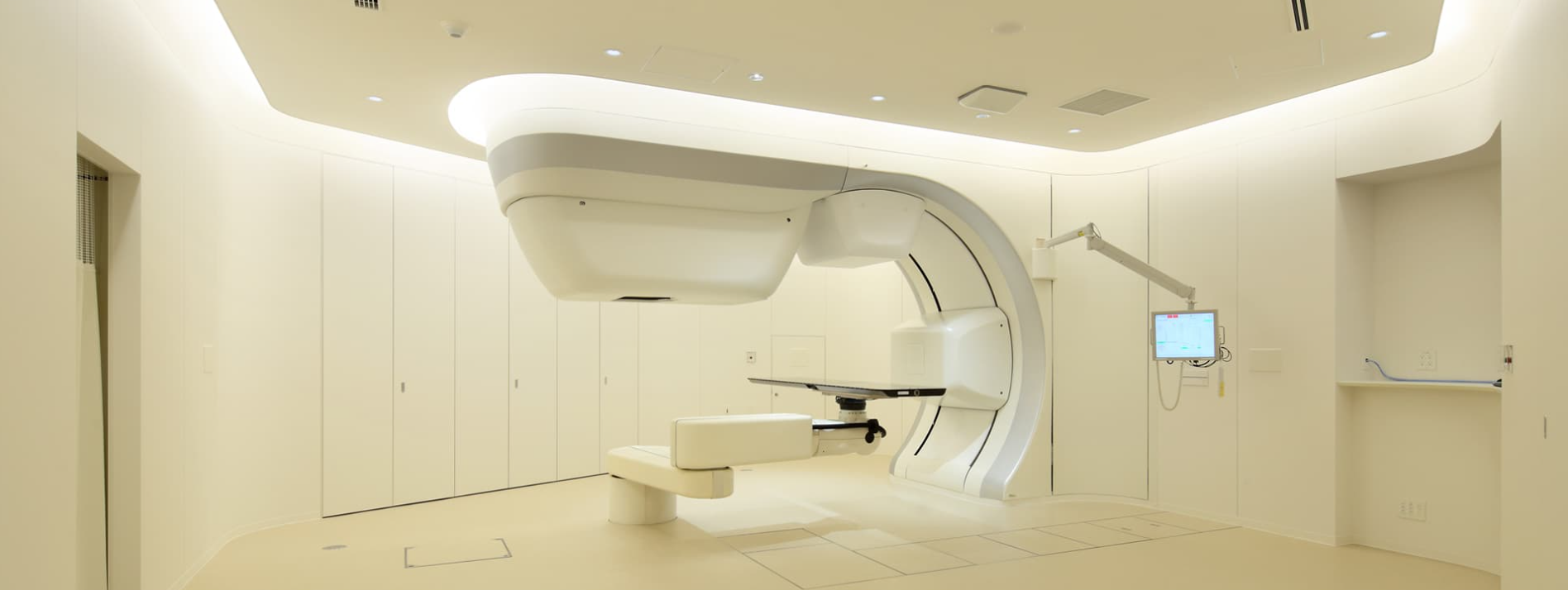
Heavy Ion Radiation Therapy
Painless and Non-invasive Heavy Ion Therapy
What is Heavy Ion Therapy?
Heavy Ion Beam Therapy: No Scalpel Pain and Less Burden on the Body
Heavy Ion Beam Therapy, which uses external beam irradiation, is also known as “no-cut” therapy, and is characterized by less pain and physical burden caused by a scalpel.
Compared to conventional radiotherapy, there are fewer side effects, and because the irradiation targets the shape and location (depth) of the cancer lesion, other organs are less affected, and an early return to society can be expected.
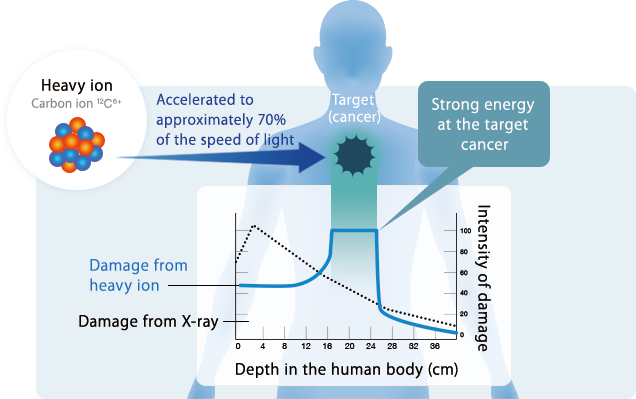
Heavy particle radiotherapy is a radiotherapy method in which carbon ions are accelerated to approximately 70% of the speed of light at maximum and irradiated to target cancer lesions.

Minimally Invasive
No pain caused by scalpels,
Gentle treatment for the elderly.
Suitable for refractory cancer
Able to target cancer lesions only,
and reduce side effects,
and can be expected to be effective for refractory cancers.
Short-term treatment
Compared to X-rays biological effect (cancer-killing effect) is 2 to 3 times higher and treatment time is short, treatment can be performed while continuing one's daily life.
the Osaka Heavy Ion Radiation Center.
Cancers Treatable with Heavy Ion Beam
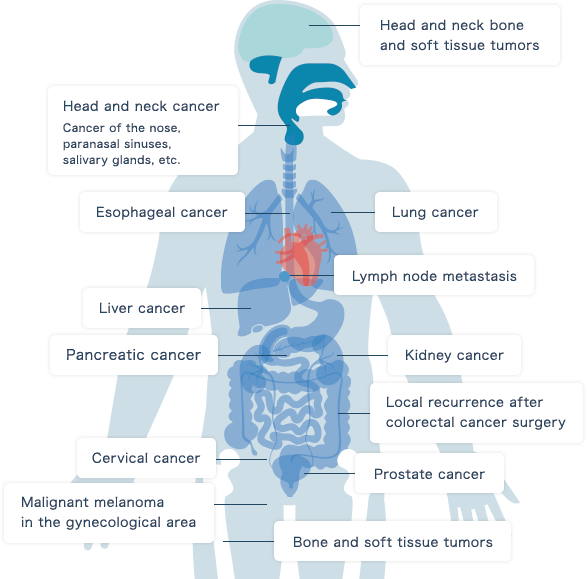
Heavy-ion cancer therapy is suitable for the treatment of localized solid cancers. It is also a treatment that avoids irradiation of normal vital organs located near the cancer.
*Cancers of the blood such as leukemia, cancers with extensive metastases, and cancers of irregularly moving organs such as stomach and colon cancer are not eligible for treatment.
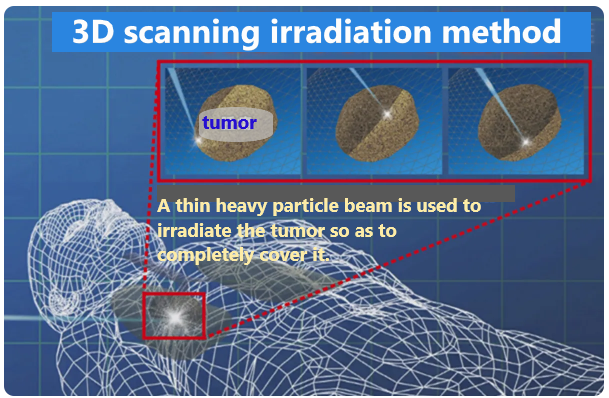
Features of Heavy Ion Beam Therapy
Concentrated irradiation of cancer lesions
In the case of X-rays, which are conventionally used for radiation therapy, the energy is at its maximum near the surface of the body and passes through the body while giving off energy. Heavy particle beams, on the other hand, reach their peak energy (Bragg peak) at a certain depth in the body and are suppressed before and after that peak. By matching the depth of the peak to the location of the cancerous lesion, it is possible to concentrate the beam only on the cancerous lesion and expect the therapy to be effective even for cancers located deep inside the body.
Heavy particle beams cure cancer with minimal impact on nearby vital organs.
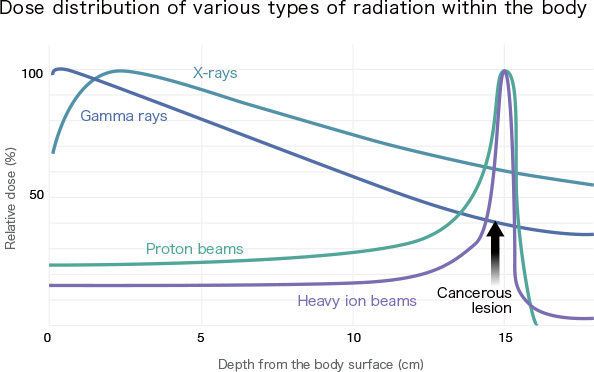
Comparison of Dose Distribution between Heavy Ion Beams and X-rays
In the Case of Heavy Ion Beams
 Heavy particle beams stop at the lesion.
Heavy particle beams stop at the lesion.
Since the maximum energy is emitted at the lesion and stops at the lesion, there is little effect on the normal tissues before and after the lesion.

*Images of irradiation
In the case of X-rays
 X-rays penetrate the lesion.
X-rays penetrate the lesion.
The dose is high near the plane of incidence and penetrates through the lesion, causing damage to the normal tissues in front of and behind the lesion.

Irradiation image
About Heavy Particle Beams
There are two types of radiation used: photon beams such as X-rays and particle beams such as heavy particle beams and proton beams. At our facility, we use heavy particle beams (carbon ions), which have higher mass than proton beams.

*Scroll to the side for more information.
Radiation used in cancer treatment
Radiation heavier than electrons is called particle beam, and radiation heavier than helium ion beams is called heavy particle beam. Heavy particle radiotherapy is a form of radiation therapy that utilizes these heavy particle beams, especially carbon ions, which are accelerated to about 70% of the speed of light and irradiated to attack cancer cells deep within the body.
In conventional radiation therapy using X-rays, the deeper inside the body, the lower the impact (strength of damage), but heavy particle therapy can set the peak of its impact (magnitude of damage) inside the body, allowing it to target cancerous lesions and irradiate them effectively.
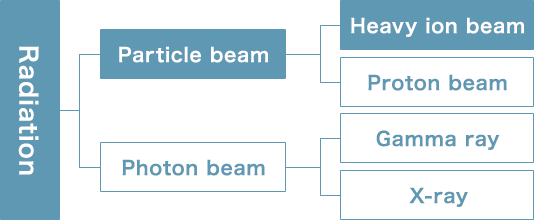
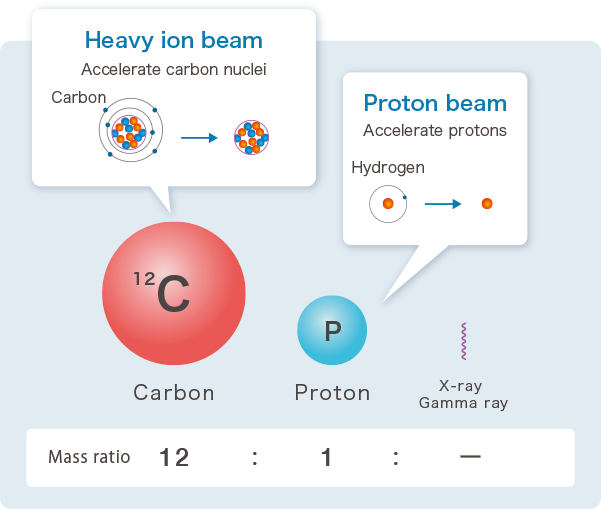
| Characteristic Evaluation of Heavy Ion Beam, Proton Beam, and X-Ray Heavy Ion Beam Proton Beam X-Ray | Heavy Ion Beams | Proton Beams | X-rays |
|---|---|---|---|
| Concentration of radiation dose | ◯ | ◯ | × |
| Effect on killing cancer cells (X-rays as 1) | 3 times | 1.1 times | 1 |
| Effect on hypoxic cancer | ◯ | × | × |
| Effects on cancers that do not respond well to radiation | ◯ | × | × |
| Fewer irradiations | ◯ | △ | × |
Source: Modified from “Heavy Ion Radiation Cancer Therapy: This Far We've Come” by Hirohiko Tsujii and Tadashi Kamada, published by San-Gaku-Sha, Inc.
Please scroll down to the side.
For those who intend to undergo treatment in Japan
For consultation on whether or not treatment is available in Japan, and
Schedule to treatment
Heavy Ion Beam Therapy
Flow of Acceptance
For those who intend to undergo treatment in Japan,
Please follow the procedures below.
Step01
Fill out and submit the designated forms
Please fill in the designated inquiry sheet and submit the “DICOM FORMA” with various test data such as CT and MRI (*In some cases, other than the DICOM FORMAT may be required).

Step02
Payment
Please pay the fee for the second opinion in Japan. As soon as the inquiry sheet and test data are ready, we will make a request to the medical institution in Japan for applicability.
Notes
It takes about 7 days from the time when the inquiry sheet and various test data are received to the time when the applicability is determined.
Please be aware of the time it takes to send the test data to Japan.
(Depending on the accuracy of the inspection data, you may be instructed to come to Japan for the inspection.)

Step03
Proposal of telemedicine consultation (remote second opinion)
Step If there is a possibility that the treatment is applicable in Step 02, we will propose a telemedicine consultation (remote second opinion). If the telemedicine consultation (remote second opinion) is conducted and there is a possibility that the treatment is applicable again, and the patient wishes to undergo the treatment, we will guide the patient through the procedures for visiting Japan for treatment.

Step04
Procedures for visiting Japan for treatment
If the patient is eligible for treatment, the medical travel support company will visit the patient's country of origin to complete the procedures for treatment.
Notes
It usually takes about 3 weeks to 1 month from the presentation of the treatment schedule.
*All fees, including procedural support fees, treatment fees, and travel expenses, must be paid before leaving Japan.
*We ask that you follow up in your home country after treatment is completed and you return to your home country.


